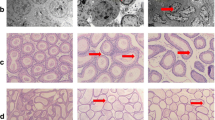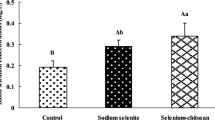Abstract
The present study was conducted to investigate the effects of supranutritional selenium nanoparticles (SeNPs) on immune and antioxidant capacity in rats. Forty male Sprague-Dawley (SD) rats were randomly divided into four groups and given intragastric administration of SeNPs at doses of 0, 0.2, 0.4, and 0.8 mg Se/kg BW, respectively, for 2 weeks. Serum immune parameters, serum and organic tissues (liver, heart, kidney) antioxidant indices, and liver mRNA expression of glutathione peroxidase 1 (GPx1) and glutathione peroxidase 4 (GPx4) were examined. The results showed that supranutritional doses of 0.4 and 0.8 mg Se/kg BW SeNPs promoted the immune responses in serum. SeNPs administration improved antioxidant capacity in the liver and kidney, and the best improvement on antioxidant capacity was found in the kidney. Furthermore, intragastric administration of SeNPs upregulated mRNA expression of GPx1 and GPx4 in the liver. The results obtained indicated that SeNPs administration at supranutritional levels had beneficial effects on immune and antioxidant capacity and supplemental SeNPs at dose of 0.4 mg Se/kg BW exhibited the best response in SD rats.


Similar content being viewed by others
Data Availability
The datasets generated during and/or analyzed during the current study are available from the corresponding author on reasonable request.
References
Kong YY, Li SQ, Ming F, Chuan W, Yang YX, Zhao NN, Li MZ (2019) Effect of dietary organic selenium on survival, growth, antioxidation, immunity and gene expressions of selenoproteins in abalone Haliotis discus hannai. Aquac Res 50:847–855
Schomburg L (2011) Selenium, selenoproteins and the thyroid gland: interactions in health and disease. Nat Rev Endocrinol 8(3):160–171
Bellinger F, Raman A, Reeves M, BERRY M (2009) Regulation and function of selenoproteins in human disease. Biochem J 422(1):11–22
Tapiero H, Townsend DM, Tew KD (2003) The antioxidant role of selenium and selenocompounds. Biomed Pharmacother 57(3–4):134–144
Kumar N, Krishnani KK, Gupta SK, Sharma R, Baitha R, Singh DK, Singh NP (2018) Immuno-protective role of biologically synthesized dietary selenium nanoparticles against multiple stressors in Pangasinodon hypophthalmus. Fish Shellfish Immunol 78:289–298
Qiu WY, Wang YY, Wang M, Yan JK (2018) Construction, stability, and enhanced antioxidant activity of pectin-decorated selenium nanoparticles. Colloids Surf B: Biointerfaces 70:692–700
Liu L, He Y, Xiao Z, Tao W, Zhu J, Wang B, Liu Z, Wang M (2017) Effects of selenium nanoparticles on reproductive performance of male Sprague-Dawley rats at supranutritional and nonlethal levels. Biol Trace Elem Res 180:81–89
Xu C, Qiao L, Ma L, Yan S, Guo Y, Dou X, Zhang B, Roman A (2018) Biosynthesis of polysaccharides-capped selenium nanoparticles using Lactococcus lactis NZ9000 and their antioxidant and anti-inflammatory activities. Front Microbiol 9:1129–1140
Xu C, Qiao L, Guo Y, Ma L, Cheng YY (2018) Preparation, characteristics and antioxidant activity of polysaccharides and proteins-capped selenium nanoparticles synthesized by Lactobacillus casei ATCC 393. Carbohydr Polym 195:576–585
Sadeghian S, Kojouri GA, Mohebbi A (2012) Nanoparticles of selenium as species with stronger physiological effects in sheep in comparison with sodium selenite. Biol Trace Elem Res 146(3):302–308
Wu HL, Li XL, Liu W, Chen TF, Li YH, Zheng WJ, Man CW, Wong MK, Wong KH (2012) Surface decoration of selenium nanoparticles by mushroom poly- saccharides-protein complexes to achieve enhanced cellular uptake and anti-proliferative activity. J Mater Chem 22(19):9602–9610
Mary TA, Shanthi K, Karuppaiya V, Soundarapandian K (2016) PEG functionalized selenium nanoparticles as a carrier of crocin to achieve anticancer synergism. RSC Adv 6(27):22936–22949
Bai KK, Hong BH, He JL, Hong Z, Tan R (2017) Preparation and antioxidant properties of selenium nanoparticles-loaded chitosan microspheres. Int J Nanomedicine 12:4527–4539
Kong H, Yang J, Zhang Y, Fang Y, Nishinari K, Phillips GO (2014) Synthesis and antioxidant properties of gum arabic-stabilized selenium nanoparticles. Int J Biol Macromol 65:155–162
Papp LV, Lu J, Holmgren A, Khanna KK (2007) From selenium to selenoproteins: synthesis, identity, and their role in human health. Antioxid Redox Signal 9:775–806
Schwarz K, Foltz CM (1958) Factor 3 activity of selenium compounds. J Biol Chem 233:245–251
He Y, Chen S, Liu Z, Cheng C, Li H, Wang M (2014) Toxicity of selenium nanoparticles in male Sprague–Dawley rats at supranutritional and nonlethal levels. Life Sci 115(1-2):44–51
Kiełczykowska M, Kocot J, Paździor M, Musik I (2018) Selenium-a fascinating antioxidant of protective properties. Adv Clin Exp Med 27(2):245–255
Ip C, Ganther HE (1990) Activity of methylated forms of selenium in cancer prevention. Cancer Res 50(4):1206–1211
Combs GJ (2005) Current evidence and research needs to support a health claim for selenium and cancer prevention. J Nutr 135(2):343–357
Peng D, Zhang J, Liu Q, Ethan W (2007) Size effect of elemental selenium nanoparticles (Nano-Se) at supranutritional levels on selenium accumulation and glutathione S-transferase activity. J Inorg Biochem 101(10):1457–1463
Feng H, Du X, Liu J, Han X, Cao X, Zeng X (2014) Novel polysaccharide from Radix Cyathulae officinalis Kuan can improve immune response to ovalbumin in mice. Int J Biol Macromol 65(4):121–128
Ginzinger D (2002) Gene quantification using real-time quantitative PCR: an emerging technology hits the mainstream. Exp Hematol 30(6):503–512
Baowei W, Guoqing H, Qiaoli W, Bin Y (2011) Effects of yeast selenium supplementation on the growth performance, meat quality, immunity, and antioxidant capacity of goose. J Anim Physiol An N 95(4):440–448
Cai SJ, Wu CX, Gong LM, Song T, Wu H (2012) Effects of nano-selenium on performance, meat quality, immune function, oxidation resistance, and tissue selenium content in broilers. Poult Sci 91(10):2532–2539
Gong J, Ni L, Wang D, Shi BL, Yan SM (2014) Effect of dietary organic selenium on milk selenium concentration and antioxidant and immune status in midlactation dairy cows. Livest Sci 170:84–90
Mahmoud E, Karen LW (2013) Cytokines as biomarkers of nanoparticle immunotoxicity. Chem Soc Rev 42(12):5552–5576
Haibo F, Fan J, Bo H, Tian X, Bao H (2016) Selenylation modification can enhance immune-enhancing activity of Chuanminshen violaceum polysaccharide. Carbohydr Polym 153:302–311
Won HY, Jung HS, Hyun JM, Lee KY, Hyun AW, Ye-Shih H, Jung WP, Sue-Goo R, Hwang ES (2010) Glutathione peroxidase 1 deficiency attenuates allergen-induced airway inflammation by suppressing Th2 and Th17 cell development. Antioxid Redox Signal 13(5):575–587
Kim HP, Imbert J, Leonard WJ (2009) Both integrated and differential regulation of components of the IL-2/IL-2 receptor system. Cytokine Growth Factor Rev 17(5):349–366
Mohapatra P, Swain RK, Mishra SK, Behera T, Swain P, Mishra SS, Behura NC, Sabat SC, Sethy K, Dhama K, Jayasankar P (2014) Effects of dietary nano-selenium on tissue selenium deposition, antioxidant status and immune functions in layer chicks. Int J Pharmacol 10(3):160–167
Bunglavan SJ, Garg AK, Dass RS, Shrivastava S (2014) Effects of supplementation of different levels of selenium as nanoparticles/sodium selenite on blood biochemical profile and humoral immunity in male Wistar rats. Vet World 7(12):1075–1081
Nicholson JWG, Bush RS, Allen JG (1993) Antibody response of growing beef cattle fed silage diet with and without selenium supplementation. Can J Anim Sci 73:355–365
Gan F, Chen X, Liao SF, Lv C, Ren F, Ye G, Pan C, Huang D, Shi J, Shi X, Zhou H, Huang K (2014) Selenium-enriched probiotics improve antioxidant status, immune function, and selenoprotein gene expression of piglets raised under high ambient temperature. J Agric Food Chem 62(20):4502–4508
Narayanankutty A, Job JT, Narayanankutty V (2019) Glutathione, an antioxidant tripeptide: dual roles in carcinogenesis and chemoprevention. Curr Protein Pept Sci 20(9):907–917
Cao J, Guo FC, Zhang LY, Dong B, Gong LM (2014) Effects of dietary selenomethionine supplementation on growth performance, antioxidant status, plasma selenium concentration, and immune function in weaning pigs. J Anim Sci Biotechnol 5(1):46–52
Fraternale A, Paoletti MF, Casabianca A, Nencioni L, Garaci E, Palamara AT, Magnani M (2009) GSH and analogs in antiviral therapy. Mol Asp Med 30(1-2):99–110
Feng P, Wei J, Zhang Z (2011) Intervention of selenium on chronic fluorosis-induced injury of blood antioxidant capacity in rats. Biol Trace Elem Res 144(1-3):1024–1031
Lu Z, Wang P, Teng T, Shi B, Shan A, Lei XG (2019) Effects of dietary selenium deficiency or excess on selenoprotein gene expression in the spleen tissue of pigs. Animals (Basel) 9(12):1122–1130
Diskin CJ, Tomasso CL, Alper JC, Glaser ML, Fliegel SE (1979) Long-term selenium exposure. Arch Intern Med 139(7):824–826
Sunde RA, Zemaitis ET 2nd, Blink AB, Lawinger JA (2018) Impact of glutathione peroxidase-1 (Gpx1) genotype on selenoenzyme and transcript expression when repleting selenium-deficient mice. Biol Trace Elem Res 186(1):174–184
Papp LV, Holmgren A, Khanna KK (2010) Selenium and selenoproteins in health and disease. Antioxid Redox Signal 12(7):793–795
Wang XN, Geng ZC, Wang Y, Liu SJ, Wu ZM (2010) Effects of sources and levels of dietary selenium on the expression level of mRNA of cellular glutathione peroxidase gene in piglets. Chin J Anim Nutr 22(6):1630–1635
Qin SY, Chen F, Guo YG, Huang BX, Zhang JB, Ma JF (2014) Effects of nano-selenium on kidney selenium contents, glutathione peroxidase activities and GPx-1 mRNA expression in mice. Adv Res Mater 1051:383–387
Meng T, Liu YL, Xie CY, Zhang B, Huang YQ, Zhang YW, Yao Y, Huang R, Wu X (2019) Effects of different selenium sources on laying performance, egg selenium concentration, and antioxidant capacity in laying hens. Biol Trace Elem Res 189(2):548–555
Sunde RA, Raines AM (2011) Selenium regulation of the selenoprotein and nonselenoprotein transcriptomes in rodents. Adv Nutr 2(2):138–150
Gan L, Liu Q, Xu HB, Zhu HB, Yang YS, Yang XL (2002) Effects of selenium overexposure on glutathione peroxidase and thioredoxin reductase gene expressions and activities. Biol Trace Elem Res 89(2):165–175
Acknowledgments
We acknowledge financial support from the Three Agricultural and Six Party Research Cooperation Project of Zhejiang Province (CTZBF180706LWZ-SNY1) and the Science and Technology Research Project of Education Department of Jiangxi Province (171342).
Author information
Authors and Affiliations
Corresponding author
Ethics declarations
Conflict of Interest
The authors declare no conflicts of interests.
Additional information
Publisher’s Note
Springer Nature remains neutral with regard to jurisdictional claims in published maps and institutional affiliations.
Yuyue Jin and Yudan He are co-first author
Rights and permissions
About this article
Cite this article
Jin, Y., He, Y., Liu, L. et al. Effects of Supranutritional Selenium Nanoparticles on Immune and Antioxidant Capacity in Sprague-Dawley Rats. Biol Trace Elem Res 199, 4666–4674 (2021). https://doi.org/10.1007/s12011-021-02601-9
Received:
Accepted:
Published:
Issue Date:
DOI: https://doi.org/10.1007/s12011-021-02601-9




